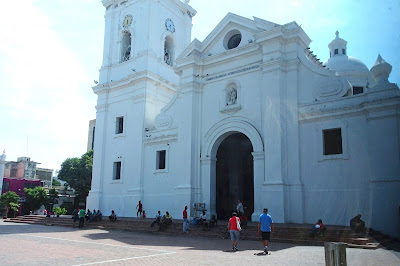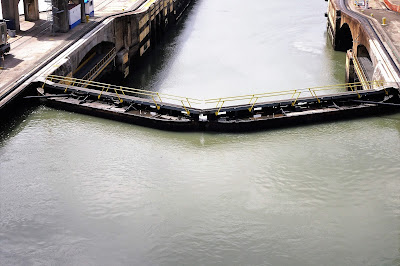We selected Crystal Cruise’s World Cruise Option 4, “South Pacific Reflections” for our 2018 adventure because, as the name implies, we spent 75% of our 98-day vacation cruising in the South Pacific – south of the equator. We left from Los Angeles, California on January 23rd and returned to Fort Lauderdale on April 30th (after passing through the Panama Canal into the Atlantic Ocean).
This was our third world cruise, and the second one with Crystal Cruises. Crystal’s two ocean-going ships – Crystal Serenity and Crystal Symphony, are mid-sized vessels (capacity of 1,070 and 850 passengers respectively), big enough to have almost all the amenities of larger sized ships, but much less crowded. Both of the ships were doing world cruises this year, on far different itineraries, but they met in Sydney, Australia on the same day. We (and 44 other world cruisers) switched ships (from Serenity to Symphony) in Sydney and experienced life on both vessels, while remaining mostly in the South Pacific.
Our observations after 25 days on board Serenity and 73 days on Symphony are very positive. We had a remarkably good trip. Both ships ran very smoothly, with nothing breaking down. Food and service in the dining venues were all exceptionally good. Officers and crew members, without exception, came across as happy to be on board and willing to do anything possible to keep us happy.
Here’s a list summarizing our experiences on World Cruise 2018 - South Pacific Reflections:
1. Making Guests Feel Special. Crystal has a strong reputation in the cruise industry for customer service. We would agree with that description. All crew members, from the Master of the Vessel on down, seemed to have safety and customer satisfaction as their top two priorities. We felt like we were very welcome guests at all times while on board both ships.
2. Entertainment for the World Cruise was absolutely superior to anything we’ve seen on any other cruise line. The permanent entertainment teams on both ships were professionals of the highest caliber. Especially noteworthy were the “house bands” on both ships. No matter what the event, be it a “headline entertainer” brought on board for one show, a world cruise special event planned on board ship, or one of the “standard shows” with the Crystal singers and dancers, the bands backed them up beautifully, almost always with little time for rehearsals.
2. Entertainment for the World Cruise was absolutely superior to anything we’ve seen on any other cruise line. The permanent entertainment teams on both ships were professionals of the highest caliber. Especially noteworthy were the “house bands” on both ships. No matter what the event, be it a “headline entertainer” brought on board for one show, a world cruise special event planned on board ship, or one of the “standard shows” with the Crystal singers and dancers, the bands backed them up beautifully, almost always with little time for rehearsals.
Most exciting of all was a World Cruise Gala Celebration at the huge auditorium in Sydney’s historic Town Hall – exclusively for full world cruise passengers on both ships, Symphony and Serenity, which were both berthed in Sydney at the same time. We all wore white clothing, and the food and local entertainment were spectacular and special. It was a wonderful evening, a once-in-a-lifetime event. We fully appreciated the effort (and cost) it must have taken to stage this memorable event. For more detail, see our blog posting for that date --
http:// wc18-jimandginny.blogspot.com/2018/02/february-18-2018-change-ships-in-sydney.html
The sail-away out of Sydney was almost as exciting, with both ships – Symphony and Serenity – cruising together out to the open sea. We don’t know if that’s ever happened before. By this time, we had moved to the Symphony, and we could watch Serenity (which had been our home for the previous 25 days) cruising along with us until leaving the harbor.
The sail-away out of Sydney was almost as exciting, with both ships – Symphony and Serenity – cruising together out to the open sea. We don’t know if that’s ever happened before. By this time, we had moved to the Symphony, and we could watch Serenity (which had been our home for the previous 25 days) cruising along with us until leaving the harbor.
- Crystal staff and crew members handled the transfer of our group of 44 world cruise passengers (including our luggage and financial information) from Serenity to Symphony very well in Sydney. The planning and execution went perfectly; thus, we were able to enjoy the world cruise on two different ships.
- The World Cruise Gala Celebration in Sydney was great -- venue, food, and entertainment were superb. Bravo to everyone involved!
- The twelve days we spent in New Zealand were the highlight of the trip for us. Scenery was beautiful (and interesting), the people were warm, friendly, and welcoming. Luckily, the weather was mostly pleasant over that period.
- Our 2-day visit to Easter Island was another highlight, as we weren’t able to reach the island on a previous cruise, due to rough seas. Meeting residents of Pitcairn Island onboard Symphony was also a positive experience.
- Technology upgrades on Symphony for unlimited free Internet access for all guests was fantastic. We had strong Internet signal every single day of the trip, even in some of the most isolated, uninhabited parts of the world. This was the case on both Jim’s PC and Ginny’s Kindle.
- There were numerous interesting enrichment lecturers on both ships, although we had some repeats at the end of the trip. One of the most notable was British-born chef Jon Ashton, who has a passion for teaching and sharing his craft. His “cookie of the day” was prepared daily by Symphony’s culinary team and stocked in two of the ship’s casual eateries – the Bistro and the Trident Grill/Scoops Ice Cream Bar.
- On Symphony, Sarah Hayes (World Cruise Hostess) and Jonathan Hawkins (World Cruise Special Events Coordinator) seemed to really care about the world cruise passengers, planning many special events, and always available to chat or help. They both are very talented entertainers and sang in solo performances many times during the world cruise.
- “Magic Castle at Sea” is always amazing. There was a new “master magician” on each segment of the world cruise. They totally astonished everyone during their up-close shows. These magicians are all performers at The Magic Castle, located in the Hollywood district of Los Angeles. Seating was limited and signups were in the library, well in advance.
- One of the better improvements made to Symphony included new, large-screen, high-def TVs in most staterooms. We hope they do the same in the Serenity refurbishment. It’s needed.
- As Cruise Director on Symphony, Shane Morely’s youthful energy and enthusiasm were contagious and much valued.
- The following features of any Full Crystal World Cruise were greatly appreciated: ground transportation to the ship from our Los Angeles hotel; photo directory of all Full World Cruise travelers – given to travelers early in the world cruise; end-of-cruise DVD, prepared by a professional videographer, showing highlights of the full experience; unlimited visits to the specialty restaurants; large selection of onboard activities, including bridge, yoga, dancing, arts & crafts, golf, computers, knitting/needlepoint, exercise and fitness (Pilates, spinning, etc.), plus many more.
None of these “nits” are meant to be overly disparaging, but merely to point out our experiences factually, as were the positive comments shown above.
For those of you who were following us on our Internet blog site
(http://wc18-jimandginny.blogspot.com), we hope you enjoyed traveling with us on this World Cruise.
Jim & Ginny
- There were only 283 Crystal full world cruisers this year, split between two ships. After some travelers swapped ships in Sydney, the breakdown was 212 (75% of the total world cruisers) on Serenity, and 71 (25% of the total world cruisers) on Symphony. This led to a feeling on Symphony that we (the world cruisers) were actually on the ship for five independent cruises ─ not a contiguous full world cruise ambience. This was not the case on our two previous world cruises on Crystal and Holland America.
- For our tastes, there were too many repeats of stage shows on every segment of Symphony’s world cruise; for example, Neil Lockwood repeated his two shows four times each. Same with the other “standard” shows. They’re all very good, but how many times can you watch the same show? In fact, there are many other activities on Symphony in which to participate, but we normally enjoy attending evening entertainment offerings.
- There wasn’t the same atmosphere in Symphony’s main dining room (Waterside) as on our previous Crystal cruises on Serenity, due to the open-seating concept. Unless we arrived at Waterside with a group of people, the two of us were always seated at a table for two. Also, the main dining room (Waterside) is now just one of many “open-seating” restaurants on the ship. More than once, we saw less than five tables occupied in the entire Waterside restaurant while we ate dinner there.
- At one point, only one entertainment show was offered per night (late at night) on Symphony, instead of the normal two showings (early & late). We assume this was because of a low passenger count on one segment.
- The last segment on Symphony was a letdown for many world cruisers. With 200+ award-winning (non-paying) travel agents on board, everyone on ship seemed to be catering to them. Several venues on the ship were closed to other cruisers every day, because of special sessions for the travel agents. On the other hand, their presence did lead to exceptional entertainment offerings on the last segment. Crystal’s CEO was on board Symphony (to meet with the travel agents) but never bothered to even say hello to world cruise travelers (or any other passengers). In their defense, several key Crystal home office (LA) staff people attended a social function for world cruisers on board and appeared eager to talk with us.
- Every day on Symphony, there was a strong smell of cigars (and we assume cigarettes) on Deck Six coming from an always open door to the Connoisseur Club, where smoking is permitted. This was not a problem on Serenity with their Connoisseur Club.
For those of you who were following us on our Internet blog site
(http://wc18-jimandginny.blogspot.com), we hope you enjoyed traveling with us on this World Cruise.
Jim & Ginny







































